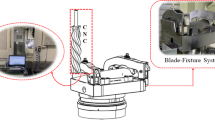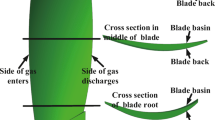Abstract
Hollow fan blades made of titanium alloy are widely used in turbofan engines, and the residual stress (RS) inside the blades directly affects the performance of the blades and even the engine. Therefore, it is crucial to measure and study the RS distribution of titanium alloy hollow fan blades. This paper aims to investigate the RS distribution on the cross-section of a wide-chord hollow fan blade made of Ti-6Al-4 V titanium alloy. The multiple-cut contour method is utilized to determine the RS. A theoretical model of the multiple-cut contour method for fan blades is established, and the specimen was cut three times, followed by contour measurement of the cut planes, data processing and elastic finite element analysis. The RS map of the three cut planes is finally presented. The normal RS on three cross-sections of the fan blade is uniformly distributed, ranging from -50 MPa to 50 MPa. The normal RS distribution at different positions for the hollow fan blade can be obtained by the proposed multiple-cut contour method. The findings of this research provide a comprehensive insight into the distribution of RS in wide-chord hollow fan blades made of Ti-6Al-4 V titanium alloy.












Similar content being viewed by others
References
Yang P, Yue W, Li J et al (2022) Review of damage mechanism and protection of aero-engine blades based on impact properties[J]. Eng Fail Anal 140:106570
Chen Z, Shi Y, Lin X et al (2019) Experimental investigation of effects of polishing process on surface residual stress of TC4 blade based on sensitivity analysis[J]. Exp Tech 43:729–738
Ramakokovhu U, Desai D, Snedden G et al (2021) Significance of residual stresses in fatigue life prediction of micro gas turbine blades[J]. Eng Fail Anal 120:105092
Yao C, Zhang J, Cui M et al (2020) Machining deformation prediction of large fan blades based on loading uneven residual stress[J]. Int J Adv Manuf Technol 107:4345–4356
Kwon HJ, Lee D, Lee YK (2021) Failure analysis of blades and vanes of a compressor for a gas turbine engine[J]. Eng Fail Anal 124:105386
Rossini NS, Dassisti M, Benyounis KY et al (2012) Methods of measuring residual stresses in components[J]. Mater Des 35:572–588
Jiang GUO, Haiyang FU, Bo PAN et al (2021) Recent progress of residual stress measurement methods: A review[J]. Chin J Aeronaut 34(2):54–78
Lin J, Ma N, Lei Y et al (2017) Measurement of residual stress in arc welded lap joints by cosα X-ray diffraction method[J]. J Mater Process Technol 243:387–394
Alinaghian M, Alinaghian I, Honarpisheh M (2019) Residual stress measurement of single point incremental formed Al/Cu bimetal using incremental hole-drilling method[J]. Int J Lightw Mater Manuf 2(2):131–139
Wang Z, Denlinger E, Michaleris P et al (2017) Residual stress mapping in Inconel 625 fabricated through additive manufacturing: Method for neutron diffraction measurements to validate thermomechanical model predictions[J]. Mater Des 113:169–177
Skouras A, Paradowska A, Peel MJ et al (2013) Residual stress measurements in a ferritic steel/In625 superalloy dissimilar metal weldment using neutron diffraction and deep-hole drilling[J]. Int J Press Vessels Pip 101:143–153
Jacob A, Oliveira J, Mehmanparast A et al (2018) Residual stress measurements in offshore wind monopile weldments using neutron diffraction technique and contour method[J]. Theoret Appl Fract Mech 96:418–427
Gadallah R, Tsutsumi S, Yonezawa T et al (2020) Residual stress measurement at the weld root of rib-to-deck welded joints in orthotropic steel bridge decks using the contour method[J]. Eng Struct 219:110946
Bonakdar A, Molavi-Zarandi M, Chamanfar A et al (2017) Finite element modeling of the electron beam welding of Inconel-713LC gas turbine blades[J]. J Manuf Process 26:339–354
Xia H, Wu J, Xu Z et al (2022) Surface residual stress detection method for aero-engine blades based on active thermal deformation excitation[J]. Nondestruct Test Eval 38:1–12
Zhang JY, Yao CF, Cui MC et al (2021) Three-dimensional modeling and reconstructive change of residual stress during machining process of milling, polishing, heat treatment, vibratory finishing, and shot peening of fan blade[J]. Adv Manuf 9(3):430–445
Lin X, Wu D, Shan X et al (2018) Flexible CNC polishing process and surface integrity of blades[J]. J Mech Sci Technol 32:2735–2746
Zhang YK, Lu JZ, Ren XD et al (2009) Effect of laser shock processing on the mechanical properties and fatigue lives of the turbojet engine blades manufactured by LY2 aluminum alloy[J]. Mater Des 30(5):1697–1703
Khadtare AN, Pawade RS, Joshi S (2020) Surface integrity studies for straight and inclined hole in micro-drilling of thermal barrier coated Inconel 718: A turbine blade application[J]. Precis Eng 66:166–179
Casuso M, Polvorosa R, Veiga F et al (2020) Residual stress and distortion modeling on aeronautical aluminum alloy parts for machining sequence optimization[J]. Int J Adv Manuf Technol 110:1219–1232
Pagliaro P, Prime MB, Robinson JS et al (2011) Measuring inaccessible residual stresses using multiple methods and superposition[J]. Exp Mech 51:1123–1134
Zhang Z, Yang Y, Li L et al (2015) Assessment of residual stress of 7050–T7452 aluminum alloy forging using the contour method[J]. Mater Sci Eng, A 644:61–68
Chandrappa K, Sumukha CS, Sankarsh BB et al (2020) Superplastic forming with diffusion bonding of titanium alloys[J]. Mater Today Proc 27:2909–2913
Gadallah R, Tsutsumi S, Aoki Y et al (2021) Investigation of residual stress within linear friction welded steel sheets by alternating pressure via X-ray diffraction and contour method approaches[J]. J Manuf Process 64:1223–1234
Author information
Authors and Affiliations
Corresponding author
Ethics declarations
Conflict of Interest
The authors declare no competing interests.
Additional information
Publisher's Note
Springer Nature remains neutral with regard to jurisdictional claims in published maps and institutional affiliations.
Rights and permissions
Springer Nature or its licensor (e.g. a society or other partner) holds exclusive rights to this article under a publishing agreement with the author(s) or other rightsholder(s); author self-archiving of the accepted manuscript version of this article is solely governed by the terms of such publishing agreement and applicable law.
About this article
Cite this article
Fan, LX., Han, N. Measurement of Residual Stress in Titanium Alloy Wide-Chord Hollow Fan Blade Based on Multiple-Cut Contour Method. Exp Tech (2024). https://doi.org/10.1007/s40799-024-00698-w
Received:
Accepted:
Published:
DOI: https://doi.org/10.1007/s40799-024-00698-w




